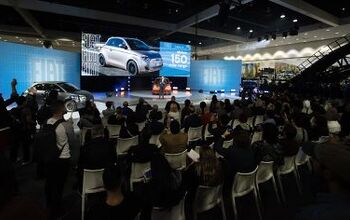Space Exploration and Research Revolutionized Auto Tech On Earth
Space may be the final frontier, but humanity’s efforts in up there resulted in new and advanced technology down here. Some of that technology has found its way into the automobile. Since it’s the 50th anniversary of humans first stepping foot on the moon, it may be a good time to check out some of the space-inspired tech in your car.
Nissan created an infographic highlighting some of the tech. Tires are the most important part of any car, and modern winter tires can trace some of its roots to the space program. Nokian developed winter tires in the 30s, but Goodyear’s special tires for the lunar rover needed to remain pliable at -195 degrees. Those are conditions that aren’t experienced on Earth.
LED lighting, used on many news cars due to their output and lower power consumption were used in space missions for growing experiments. LED diodes are more reliable than a traditional bulb. In scenarios where power is limited — like space — more energy saved is more energy that can be used for other functions.
Satellites in orbit were obviously developed for that purpose, but some things like GPS-based navigation were restricted to military and government use for the longest time. Commercial use began in the 1980s, but the government degraded the quality of the system until a bill was signed in 2000 to allow everyone to have access to the high-accuracy location system. Now you use it for everyday navigation.
Seat technology has also advanced because of the space program. Astronauts spend a considerable time seated on missions, which can have adverse affects on health. The seats are also expected to handle the G loads of launch and re-entry. Automotive seat manufacturers like Recaro focus on those ergonomic issues, while still developing seats to hold airbags and other technology demanded by earthly consumers.
Nissan’s own seats, which they call Zero Gravity, were co-developed with engineers from NASA to address ergonomics and comfort.
Finally, coatings and shielding designed to protect a spacecraft have practical applications in both motorsports and everyday driving. Not only that, but the technology must be lightweight. Coatings for brakes, heat shields and uses of aluminum and carbon fiber all have spent time in space being developed.
Space exploration and research is expensive and time-consuming, but the benefits often trickle down to everyday uses here on Terra Firma.
[Image: Nissan]
More by Chad Kirchner
Latest Car Reviews
Read moreLatest Product Reviews
Read moreRecent Comments
- Ajla A union fight? How retro 😎
- Analoggrotto Finally, some real entertainment: the Communists versus the MAGAs. FIGHT!
- Kjhkjlhkjhkljh kljhjkhjklhkjh *IF* i was buying a kia.. (better than a dodge from personal experience) .. it would be this Google > xoavzFHyIQYShould lead to a 2025 Ioniq 5 N pre-REVIEW by Jason Cammisa
- Analoggrotto Does anyone seriously listen to this?
- Thomas Same here....but keep in mind that EVs are already much more efficient than ICE vehicles. They need to catch up in all the other areas you mentioned.

































Comments
Join the conversation
Nissan makes a lot of noise about their zero-g seats, which are stunningly uncomfortable.
"Nissan makes a lot of noise about their zero-g seats, which are stunningly uncomfortable." Yeah but that is for vertical take off not for driving on the road horizontally.